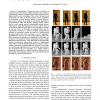52 search results - page 8 / 11 » View-Invariant Representation and Learning of Human Action |
118
click to vote
IROS
2009
IEEE
15 years 6 months ago
2009
IEEE
— Programming a humanoid robot to perform an action that takes the robot’s complex dynamics into account is a challenging problem. Traditional approaches typically require high...
ECCV
2004
Springer
16 years 1 months ago
2004
Springer
We introduce a novel approach to modeling the dynamics of human facial motion induced by the action of speech for the purpose of synthesis. We represent the trajectories of a numbe...
112
click to vote
NIPS
2008
15 years 1 months ago
2008
Research in animal learning and behavioral neuroscience has distinguished between two forms of action control: a habit-based form, which relies on stored action values, and a goal...
120
click to vote
ATAL
2005
Springer
15 years 5 months ago
2005
Springer
Reinforcement learning problems are commonly tackled with temporal difference methods, which use dynamic programming and statistical sampling to estimate the long-term value of ta...
CIVR
2007
Springer
15 years 5 months ago
2007
Springer
This paper addresses the problem of classifying actions performed by a human subject in a video sequence. A representation eigenspace approach based on the visual appearance is us...

